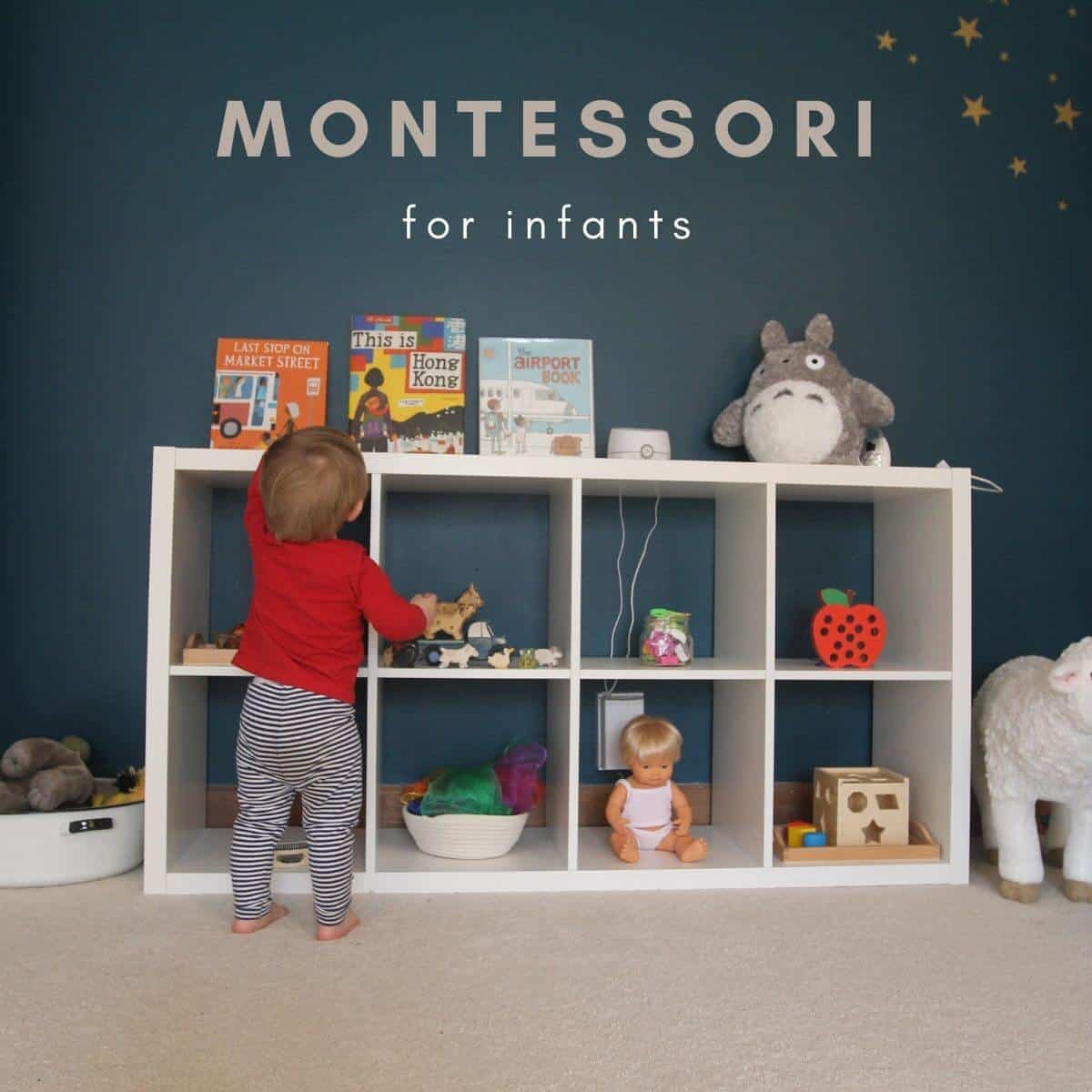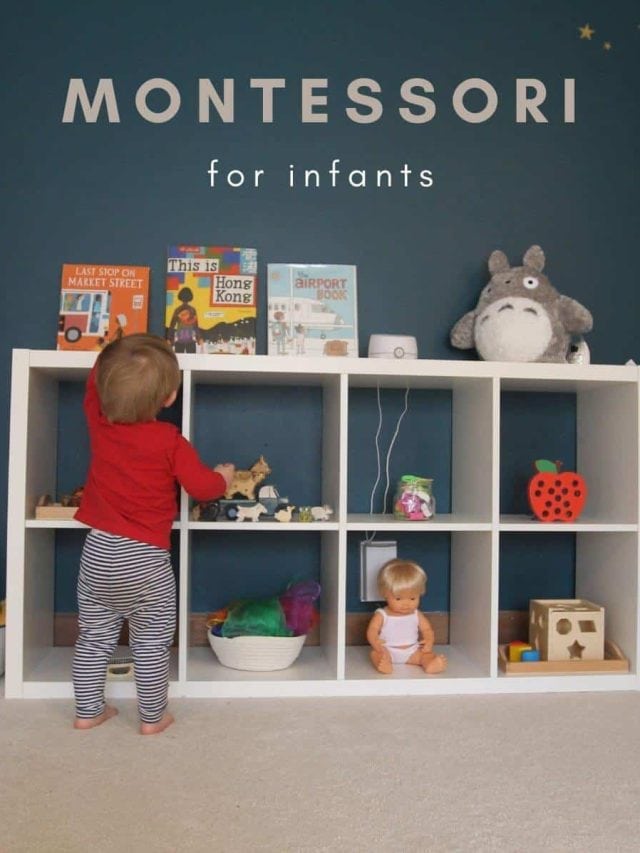I stumbled across an article discussing the joys of Montessori for infants while I was pregnant with my son. The article featured a classroom with open shelves perfectly lit by sun beams streaming in from large picture windows.
The children seemed serene as they scooped beans into a bowl or arranged flowers into a small vase. I bookmarked the article thinking I’d use it for nursery inspiration.
I could not have guessed how much I would ultimately lean on this parenting and education philosophy to get me through early motherhood.
If I could describe the first year of parenting my son in one word, it would be “relentless.”
Exhausted and numb, I gave myself a pep talk each morning.
It was easier to feel positive in the bright daylight when my sense of purpose had not been eroded by fear, fatigue, and repeated missed connections with my son.
Like so many new mothers, I believe I experienced undiagnosed postpartum depression. While the world slept, I read nonstop about baby sleep, breastfeeding, and parenting philosophy.
One day my son will smile at me. One day I’ll be a good mother like I said I would.
I was miserable but determined.
- What Is Montessori for Infants?
- What Age is the Best to Start Montessori?
- Finding your Groove as a Montessori Parent
- Welcome Baby Home with a list of Montessori Newborn Essentials
- Infant Montessori Materials that Probably Aren’t on Your Baby Registry Must Haves List
- Classic Infant Montessori Toys
- Controversial Montessori Registry Item: The Floor Bed
- Understanding your Child’s Sense of Order
- Freedom of Movement is Key in Montessori for Infants
- Resources for Montessori for Infants
Using Montessori for Infants to Help Myself Learn to Parent
I had no maternal urges myself after the birth of my son, so I parroted the motions of other mothers I admired.
One of those mothers was Maria Montessori. Dr. Montessori practiced immeasurable love and respect for children.
I am not a self-proclaimed expert on Montessori for infants or a trained Montessori teacher. But I am a mother who is constantly working to raise a joyful, curious, and compassionate person from birth.
We run a “Montessort-of” home, borrowing from many different parenting philosophies. I take what works for my son and leave the rest.
In this article, I’ll share all the ways I took advantage of Montessori techniques to build a healthy, secure relationship with my baby boy from birth.

This site contains affiliate links, meaning that we earn a small commission for purchases made through our site. We only recommend products we personally use, love, or have thoroughly vetted.
What Is Montessori for Infants?
Montessori is a parenting method and educational curriculum that allows children to learn at their own pace with the goal of increasing independence.
It was Dr. Montessori’s life’s work to bring about a revolution in how adults related to and educated little ones.
Her writings and the guidance of other Montessori parents helped me lay a foundation for connection with my son that eventually blossomed into my dream relationship.
In The Secret of Childhood, Maria Montessori describes the experience of being born as earth-shattering.
She suggests that our job as caregivers is to gently transition our child to the world by providing a warm, dark, comforting, and consistent environment.
She writes, “The feeling we should have towards the newborn baby is not the compassion that we have for the sick or weak, but reverence before the mystery of creation, the secret of an infinite taking bounded form.”
In her observations, newborn babies have a complex and well-developed internal life with innate preferences and personalities. As parents, we must respect our babies as we would respect any other adult.

What Age is the Best to Start Montessori?
Montessori has long been associated with toddlerhood, but in fact, there are Montessori curriculums and independent schools for children all the way to young adulthood.
Montessori parenting techniques can benefit children from day one.
In fact, preparing a home for a Montessori baby requires less stuff and less space, which means you will also spend a lot less time cleaning up.
Finding your Groove as a Montessori Parent
One of the greatest skills you can master as a Montessori parent is the skill of objective observation.
Through observation, the parent identifies tasks that interest the child. This helps the caregiver provide more opportunities for them to work on it.
In the same way you might be obsessed with a specific book, blog, or subject, babies are obsessive, too.
I like to think of these baby obsessions as “hobbies,” though they require serious concentration and work.
Baby hobbies include things like tracking objects with their eyes, improving the motor control they use to move their arms up and down, or learning how to roll over. Some hobbies are passing, but others can go on for months.
As a mother who felt leagues away from her child emotionally, it was comforting to consider that being objective and removed from your child through observation could actually help bring you together.
Observation can put you both on the same page. The child can sense you are aware of what they are trying to do before they can even speak.
To them, perhaps, it feels like magic.
How to Practice Observation
A very simple way to practice observation is to put your phone out of reach and sit a foot or so away from your child while they are lying awake or during play.
Do not move or speak or listen to a podcast.
Quietly observe for five minutes and write down your observations in a notebook as if you were trying to explain to a blind individual what your baby is doing.
You may say, “She’s lying on her back on a blanket on the floor. Her hands are outstretched in front of her. She waves her hands about, and her eyes are following her right hand. Her right hand struck a toy dangling above her head, and she started to look at the toy.”
If your baby is repeatedly interested in batting hanging toys, all you need to do is give her the quiet time, materials, and space to do so.
Slowing Down to Care for your Infant
Montessori offers a a road map to form bonds with your children during day-to -day tasks such as diaper changes, getting dressed, and eating.
Borrowed from the RIE parenting philosophy, Montessori encourages parents to slow down during infant care activities and to explain what you are doing out loud at each step in the process.
Sometimes, if you are addressing the child directly, you can even pause to wait for a response.
As a new mother without the faintest idea of how to talk to babies, this technique of explaining everything I was doing gave me confidence and kept my mind in the present.
It also felt respectful to my son who, thanks to this technique, is now well-versed in the vocabulary of our daily lives.
He is more knowledgeable of his own self-care as well, as the skills he needs to improve upon to gain independence.
At just 18 months, he is already learning how to pull up his own pants, wash his hands, and brush his teeth.
Even for my late blooming baby, our Montessori approach has fostered a very confident, independent toddler.

Welcome Baby Home with a list of Montessori Newborn Essentials
A Montessori inspired baby space is simple, naturally or warmly lit, and organized.
It absolutely does not need to be Pinterest perfect or include $200 wooden toys handmade by elves in Finland.
Montessori infant toys focus on helping babies work on milestones throughout their first year of life. This can include things like palmar grasp, responding to sounds, and all the skills needed to start crawling.
Our home is full of plastic dollar store bins, repurposed objects, and thrifted finds. We try to weigh practicality and child development against having a home straight out of a West Elm catalogue.
Many families will set up a baby play space in the main area of their home so their baby can observe daily life.
The Kavanaugh Report has a wonderful example of a simple but beautiful newborn baby space. This area can grow with your baby as you add on more age appropriate toys or equipment.
Infant Montessori Materials that Probably Aren’t on Your Baby Registry Must Haves List
Here’s a quick list of some common Montessori newborn essentials to purchase, DIY, or thrift when creating your baby’s play space.
Get creative! Your infant or toddler’s social and emotional education will benefit from it, and their absorbent minds will learn through play.
1. Munari Mobile or any high contrasting color, slow moving mobile
Newborns give their full concentration to visually track objects, especially black and white ones, so Montessori education suggests mobiles should never be placed over a child’s sleeping area.

In addition to this mobile, you may also see wooden loops or bells that can be hung from the ceiling and batted back and forth.
2. Topponcino, or the best baby item you’ve never heard of
Described in Dr. Montessori’s writings, a topponcino is a small, soft mattress that can be used from birth to provide a comfortable and consistent surface (and play area) for your baby.

An infant can go from lying on the ground to placed in their bassinet, to held by a family member, and back to the floor–all while staying cradled on their same snug mattress.
It is the holy grail of Montessori baby items. I am honestly devastated that I found out about this when our son was already a year old.
3. Low Mirror at infant’s level
A low mirror can be mounted to the wall at floor level. This is intended to allow babies to fully visualize their own movements and map out their bodies over time.

My son had full conversations with his reflection, and it was as adorable as it sounds.
4. Plants or fresh flowers
This is simply to add beauty to your child’s environment, and who doesn’t love looking at a vase of fresh flowers?

Classic Infant Montessori Toys
- A bell or wooden rattle to help baby understand cause and effect
- Interlocking discs for passing between hands and visual tracking
- Grasping beads or grasping toys for developing palmar grasp
- Ball cylinder to encourage movement
- Fabric grasping ball for developing palmar grasp
Controversial Montessori Registry Item: The Floor Bed
One of the most controversial Montessori registry items is the floor bed.
In terms of sleeping arrangements, Dr. Montessori did not describe the sleeping area for babies in great detail.
In my opinion, there is too much emphasis in the Montessori community on establishing independent sleep for babies as young as 2 months old.
Rather than follow any sort of Montessori guidance for sleep, we chose to slowly transition our son to a crib followed by a floor bed with railing at 18 months.
I have heard many wonderful things about floor beds, but it did not feel right for our family at the time.
Understanding your Child’s Sense of Order
From birth to age six, Montessori parents consider their children to be in a very sensitive period for understanding order.
Babies absorb information in their environment faster than any other time in their life. Their brains develop at a rapid pace.
They will begin to notice the rhythms to their day; the placement of different objects around the home; and the order in which things are done.
Setting up an orderly baby space will allow your child to make a clearer mental map of their home. When your baby becomes mobile, you may be delighted to discover that they wander over to the book shelf when you ask them if they’d like to read.
Or, they may even open a drawer full of plates when you tell them it’s snack time. This gives them a sense of dignity and confidence that they can make their own contributions to the household.
Maintaining Order in Your Home
One easy way to maintain order in a baby’s space is to limit the number of available toys to a few items that you think your child will want to use.
You can gradually increase the number of toys available as they get older, but newborns need just a few activities to stay satisfied without being overstimulated.
I don’t want you to feel any pressure to keep your house perfectly spotless all the time! In fact, most Montessori homes, especially with multiple children, often look more like this.
When you are exhausted and depressed postpartum, the very last thing you want to do is clean your house.
So the Montessori method benefits you, too, mama! The mental energy required to put away three toys or four board books that always go in the exact same spot every time is practically nonexistent.
In fact, if everything goes back to the same place, your partner can also easily help tidy instead.
I have personally tested this out on my spouse, and my wonderfully unobservant partner has started putting things away in their proper place without any prompting. Montessori environments can affect partners, too…
Results may vary, but give it a shot!

Freedom of Movement is Key in Montessori for Infants
More than any other Montessori principle, parents often resist offering children freedom of movement.
Allowing your baby freedom of movement means leaving all their limbs and head completely free to move about in any direction.
With the exception of tummy time, this looks like simply laying your baby on a flat, soft surface like a high pile rug, blanket, or the aforementioned Toppocino.
Parents often use some sort of “baby container” such as a bouncy seat, exerciser, or swing that restricts movement with the greatest of intentions.
These devices will prop your baby up into a position that they might be working to achieve such as sitting up or standing.
However, it might surprise you that many of these “baby holders” are not generally recommended by infant physical therapists, and you’d never want your baby to spend a lot of time in one.
Freedom of Movement for Mobile Babies
For mobile babies, allowing freedom of movement includes providing lots of open space to explore and a judicious amount of baby-proofing.
A good goal is to have at least one room in your house where your child is safe to explore independently without your presence, but giving your child routine access to most of the home is even better.
It can be a lot of work for parents to constantly keep their eyes on a roving baby! I have spent many a day tidying behind my curious toddler who insisted on pulling every item out of every drawer.
Offering freedom of movement is a hard decision to make, but I try to see things from my son’s perspective as he can’t yet explain to me what he is doing when he opens all those drawers.
I believe he’d say, “After months of work, just as I start to scoot around and attain the skills to explore the house fully, you start to limit and to take away all the things I’ve been aching to engage with by putting up barriers and removing objects. Can you not see how frustrating that is?”
In my mind, my son is very persuasive.

Freedom of Movement through Child Walks
One final way to offer freedom of movement is to go on a child walk (or crawl).
Child walks are simply outdoor walks that happen at the child’s pace. These walks allow children to wander, squat, and investigate natural objects.
They may even want to start a nature basket at home that includes items found on their walk.
Babies can also lie on a blanket in a grassy area with the option to roam out onto the lawn and explore. Let their Montessori classroom be outside!
There is something so nourishing about going outside, and setting a goal of taking your child outside has the added benefit of also being great for mental health.
Resources for Montessori for Infants
This article has barely scratched the surface of the Montessori method, so if you have enjoyed these topics and are looking for more information, you’ve come at just the right time.
The Montessori Baby by Simone Davies (who wrote the modern Montessori manual for toddlers) and Junnifa Uzodike is now available for pre-order.
Check out the Instagram pages for Montessori Like a Mother and Montessori Madre. Both of these mamas (at the time this article was written) are about to give birth soon!
Montessori for infants is a great way to bond with your baby during their first year. If you’ve used this method, what are some of your tips and tricks?
Montessori for infants is a special methodology for parenting and educating children. It was created by Dr. Maria Montessori who encouraged parents to observe children and to follow their natural desires to learn. Using a Montessori approach, parents practice treating their children with respect, offering freedom of movement within limits, and working with a young child’s innate sense of orderliness.
Montessori for infants requires only a small number of materials compared to a traditional baby registry list. A Montessori infant may need a handful of simple but specialized toys that can be easily found online, a soft flat surface for play, a clean and orderly environment, and a mattress for sleeping that is placed directly on the ground without railings. This is also known as a floor bed.
The Montessori method is specifically designed to work for children of all ages and temperaments. In fact, Montessori parents adhere to the principle of “follow the child,” meaning that how parents apply Montessori is shaped by their child’s unique needs and timelines.











